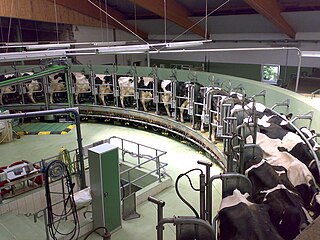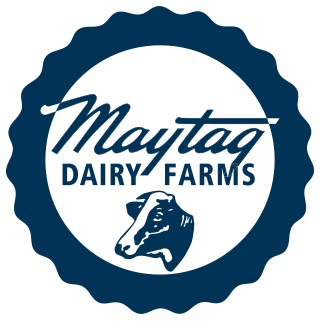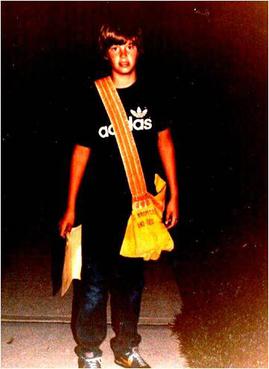
Milk is a white liquid food produced by the mammary glands of mammals. It is the primary source of nutrition for young mammals before they are able to digest solid food. Milk contains many nutrients, including calcium and protein, as well as lactose and saturated fat. Immune factors and immune-modulating components in milk contribute to milk immunity. Early-lactation milk, which is called colostrum, contains antibodies and immune-modulating components that strengthen the immune system against many diseases. The US CDC agency recommends that children over the age of 12 months should have two servings of dairy (milk) products a day, and more than six billion people worldwide consume milk and milk products.

Veal is the meat of calves, in contrast to the beef from older cattle. Veal can be produced from a calf of either sex and any breed; however, most veal comes from young male calves of dairy breeds which are not used for breeding. Generally, veal is more expensive by weight than beef from older cattle. Veal production is a way to add value to dairy bull calves and to utilize whey solids, a byproduct from the manufacturing of cheese.

The Holstein Friesian is an international breed or group of breeds of dairy cattle. It originated in Frisia, stretching from the Dutch province of North Holland to the German state of Schleswig-Holstein. It is the dominant breed in industrial dairy farming worldwide, and is found in more than 160 countries. It is known by many names, among them Holstein, Friesian and Black and White.

Dairy farming is a class of agriculture for the long-term production of milk, which is processed for the eventual sale of a dairy product. Dairy farming has a history that goes back to the early Neolithic era, around the seventh millennium BC, in many regions of Europe and Africa. Before the 20th century, milking was done by hand on small farms. Beginning in the early 20th century, milking was done in large scale dairy farms with innovations including rotary parlors, the milking pipeline, and automatic milking systems that were commercially developed in the early 1990s.

Milk delivery is a delivery service dedicated to supplying milk, typically in bottles or cartons, to customers' homes. This service is performed by a milkman, milkwoman, or milk deliverer. The delivery route is a milk route or milk run.

Dairy cattle are cattle bred with the ability to produce large quantities of milk, from which dairy products are made. Dairy cattle generally are of the species Bos taurus.

Maytag Dairy Farms is a manufacturer of blue cheese, as well as other dairy products. It is based in Newton, Iowa, United States.

John David Gosch was a paperboy in West Des Moines, Iowa, who disappeared between 6 and 7 a.m. on September 5, 1982. He is presumed to have been kidnapped. Gosch's picture was among the first to be featured on milk cartons as part of a campaign to find missing children. As of 2024, there have been no arrests made and the case is now considered cold, but remains open.

The Iowa Cow War was a series of violent disputes over the testing of cows for bovine tuberculosis in 1931. After distrustful farmers tried and failed to repeal the testing program, they congregated to block tests from taking place. The farmers believed that the test might infect cows with tuberculosis or make pregnant cows have spontaneous abortions. They also believed that the testing was unconstitutional. The owner of Muscatine radio station KTNT, Norman G. Baker, spread misinformation which resulted in more farmers protesting the testing, sometimes violently. Fifty veterinarians, all working in pairs and while being protected, gave injections to 5,000 cattle per day for a week. The Iowa Cow War came to a conclusion when 31 Iowa National Guard units were deployed to stop the protesting. Two farmers were arrested for their actions during the conflict. There was one casualty, and no deaths. Most of the testing was completed by October 1931.

From the second half of the 19th century, milk has been packaged and delivered in reusable and returnable glass bottles. They are used mainly for doorstep delivery of fresh milk by milkmen. Once customers have finished the milk, empty bottles are expected to be rinsed and left on the doorstep for collection, or rinsed bottles may be returned to a participating retail store. Bottle sizes vary depending on region, but common sizes include pint, quart or litre.
Oberweis Dairy, headquartered in North Aurora, Illinois, is the parent company of several dairy-related and fast food restaurant operations in the midwest region of the United States. Its businesses include a home delivery service available in parts of Illinois, Indiana, Missouri, Michigan, North Carolina, Texas, and Wisconsin, which delivers traditional dairy products, including milk, ice cream, cheese, and yogurt, as well as bacon and seasonal products.

Clover Sonoma, formerly Clover Stornetta Farms is a dairy company located in Sonoma County, California, along the Pacific coast in Northern California. It is a brand that has existed since the early 1900s, when the Petaluma Cooperative Creamery served the city of Petaluma. In 1977, Clover Stornetta Farms, Inc. was formed from the joining of two separate companies: Stornetta's Dairy and the Petaluma Cooperative Creamery. Clover Sonoma currently has farms in Sonoma County, Marin County, and Mendocino County, California. In 2021, Clover Sonoma launched Clover the Rainbow, a sister dairy brand that makes a line of kids' organic yogurt smoothies.
The 1933 Wisconsin milk strike was a series of strikes conducted by a cooperative group of Wisconsin dairy farmers in an attempt to raise the price of milk paid to producers during the Great Depression. Three main strike periods occurred in 1933, with length of time and level of violence increasing during each one.

There are ten states in the United States of America with container deposit legislation, popularly called "bottle bills" after the Oregon Bottle Bill, the first such legislation that was passed.

The Newens Sanitary Dairy Historic District is located in Des Moines, Iowa, United States. It consists of three buildings, the former dairy buildings and the Newens’ family home. The district has been listed on the National Register of Historic Places since 2003.
Rockview Farms was established in Downey, California, in 1927 by Bob Hops. In 1930, Mr. Joseph J. McCandless organized the dairy. In 1938, Rockview Farms won a gold medal in the raw milk exhibit at the Los Angeles County Fair. The McCandless brothers were selling retail with the help of Joseph McCandless' wife from Ireland.
Beginning in the early 1980s, advertisements on milk cartons in the United States were used to publicize cases of missing children. The printing of such ads continued until the late 1990s when other programs became more popular for serving the same purpose. Contemporary popular media portrayed the practice in fiction, often in a satirical manner.

The Food Sciences Building, formerly known as Dairy Industry Building, is a historic building on the campus of Iowa State University in Ames, Iowa, United States. The two-story, Bedford stone structure was designed by the Des Moines architectural firm of Proudfoot, Rawson & Souers. J. and W. A. Elliott Construction completed it in 1928. Additions to the original building were completed in 1962, 1991, and 1993. It was listed, along with its courtyard sculptures, on the National Register of Historic Places in 1987.
Russell Van Dyke was a broadcast journalist during the early years of television in Iowa, known as "The Walter Cronkite of Iowa" and the dean of the state's newscasters. Van Dyke was born in Adams, Nebraska, and lived in Des Moines, Iowa for 40 years. After retiring in 1983, he moved to Clear Lake, Iowa with Janice, his wife of 41 years.














